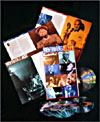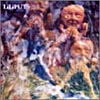
Comment
on this story
|
 |

This Week: This Week: Ken Burn's take on jazz, LiLiPUT's gems unearthed, and Spoon's instant gratification.
Various Artists

Ken Burns' JAZZ: The Story of America's Music (Columbia/Legacy)
What connects 1930s Benny Goodman to 1960s John Coltrane? What circumstances find Sidney Bechet together with Grover Washington Jr.? The answers are in Ken Burns' five-CD collection JAZZ: The Story of America's Music.
Featuring music from Burns' JAZZ, the 10-part documentary aired on PBS, this set and accompanying booklet comprise one component of the film's extensive merchandising, which includes DVDs/videos, a jazz history, a "best of" CD, and 22 individual CD releases. As such, America's Music might suffer from the criticism of myopia and incompleteness leveled at the film, although as an anthology the collection's gathering of classic tunes rivals The Smithsonian Collection of Classic Jazz (1987).
For those of us whose focus is recordings from the last 30 years, it may seem off-putting that only 9 of 94 tunes collected date from 1970 or later. Not that America's Music is exhaustively representative even within the period to which it confines itself. The obvious greats are in evidence (Armstrong, Morton, Ellington, Basie, Young, Holiday, Fitzgerald, Parker, Gillespie, Mingus, Davis, etc.) but listeners are likely to identify omissions (e.g., Wes Montgomery, a personal favorite).
Tune selection in this set is influenced by an objective distinct from other jazz anthologies: to cement Armstrong and Ellington as jazz's cornerstones. Consequently, Ellington and Armstrong cuts appear on four of the collection's five CDs, appropriately enough as they continued to record into the '70s.
But the beauty of chronological anthologies is their capture of jazz's developments, its artists' antecedents, and America's Music is no exception. Contrast George Mitchell's cornet solo on "Dead Man Blues" with Armstrong's on "Potato Head Blues" a year later, and experience the emergence of swing time feel. Consider that extended soloing over harmonic stasis manifested in Benny Goodman's 1937 "Sing, Sing, Sing" was extended further by Coltrane 30 years later.
These and other aural delights are to be discovered throughout this collection and its informative booklet, a passport to the sights and sounds of a century of jazz.
—Jonathan B. Frey
LiLiPUT

LiLiPUT (Kill Rock Stars)
On "Nightroad," the first single the Swiss punk rock group LiLiPUT recorded, guitarist Marlene Marder sounds as though she learned the chords just moments earlier. And as the song nears the end, the band speeds up the tempo, as if they were overcome with excitement rushing to the end. The whole thing sounds unplanned, wrong even. But it also sounds completely natural and wonderful—a rare mix of artiness and primal instinct. It marks all of their work.
LiLiPUT (or Kleenex, as they were called before the tissue company made them change their name) were just one of hundreds of punk bands forming in the late '70s, and they didn't garner much attention. After recording a handful of EPs and two LPs, they gave up in 1983. The all-female group has been a fetish of music geeks ever since, and their old releases have sold for hundreds of dollars. Kill Rock Stars has finally re-released the group's entire works—46 tracks over two hours and 17 minutes for the bargain basement price of $13 (post-paid)—and the recordings are as wonderful as the hype.
Through its career, the group had three lead singers, with Marder and bassist Klaudia Schiff forming the heart of the group (and their background vocals—lots of squeaks, chirps, ohhs, and woos—standout probably more than the leads). Like their contemporaries the Raincoats and the Slits, LiLiPUT broke strongly from the male mold of rock 'n' roll, and delivered something that sounds, even today, completely radical and different. It's the kind of music that makes you want to start a band, and I know no higher compliment.
Available for only $13 (send checks or money order to Kill Rock Stars, PMB 418, 120 NE Stave Ave., Olympia, WA 98501, or check out their website at www.killrockstars.com), you're a damn fool if you don't buy it this time around.
—Joe Tarr
Spoon

Girls Can Tell (Merge)
Lackluster sales of 1998's Elektra release, A Series of Sneaks, cost the Austin, Texas, band Spoon its major-label deal, but Girls Can Tell is a credible welcome back from the trio.
Marked by Britt Daniel's tight songwriting, Girls is reminiscent of the band's Matador debut, Telephono. In short, it's long on instantly gratifying guitar pop. Where A Series of Sneaks was thrashy and monotonous, Girls draws on Daniel's' vocal range to change the pace.
Spoon is often compared to early Pixies, and although Daniel isn't as fun and irreverent as Black Francis, he does have a penchant for catchy melodies. Perhaps the best track, "Lines in the Suit," alludes to the band's lack of commercial success: "I'm listening to 'Mountain to Sound' and the way it's panned is cool," ("Mountain to Sound" is from Spoon's '97 Soft Effects EP). On the rollicking "Take A Walk," Daniel takes a swipe at Elektra: "Tough break handjob sent me back home to ma—Back to cowtown and the fishshop and the mall." The slow "1020 AM" is about lost love, or perhaps a longing for old-school radio.
The songs have simple structures, to be sure, but Daniel's vocals blend the melodies with ease. Girls Can Tell isn't as fun as a Beck or Stephen Malkmus album, but it's smart pop.
—Gary Ashe

March 22, 2001 * Vol. 11, No. 12
© 2001 Metro Pulse
|